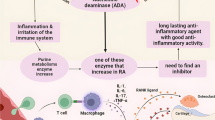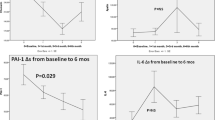Abstract
Adenosine can suppress the release of tumour necrosis factor-α (TNF-α) from activated monocytes and macrophages, and may contribute to the anti-inflammatory activities of methotrexate and sulphasalazine. Dipyridamole inhibits the cellular uptake and metabolism of adenosine and we have, therefore, examined the effects of dipyridamole in patients with rheumatoid arthritis in an attempt to alleviate their symptoms. Forty patients aged 18–75 years were randomised to receive dipyridamole 400 mg/day or placebo. Blood samples were taken at baseline and at monthly intervals for 6 months. Purines were determined by HPLC and cytokines by ELISA. After 3 months of treatment there were significant reductions in neopterin levels and in the modified Health Assessment Questionnaire score, but these were not maintained. Dipyridamole had no effect on disease severity or the levels of purine metabolites, interleukin-1β (IL-1β), IL-6, TNF-α, lipid peroxidation products, erythrocyte sedimentation rate or C-reactive protein. In conclusion, rheumatoid arthritis patients showed no clinical improvement following treatment with dipyridamole for 6 months.





Similar content being viewed by others
References
Feldmann M (1996) The cytokine network in rheumatoid arthritis: definition of TNF-α as a therapeutic target. J R Coll Phys Lond 30:560–570
Choy EHS, Panayi GS (2001) Cytokine pathways and joint inflammation in rheumatoid arthritis. New Engl J Med 344:907–916
Cohen SB, Woolley JM, Chan W (2003) Interleukin 1 receptor antagonist anakinra improves functional status in patients with rheumatoid arthritis. J Rheumatol 30:225–231
Cronstein BN, Bouma MG, Becker BF (1996) Purinergic mechanisms in inflammation. Drug Dev Res 39:426–435
Cronstein BN, Rosenstein ED, Kramer SB Weissmann G, Hirschhorn R (1985) Adenosine: a physiological modulator of superoxide anion generation by human neutrophils. Adenosine acts via an A2 receptor on human neutrophils. J Immunol 135:1366–1371
Gessi S, Varani K, Merighi S, Ongini E, Borea PA (2000) A(2A) adenosine receptors in human peripheral blood cells. Br J Pharmacol 129:2–11
Bshesh K, Zhao B, Spight D, Biaggioni I, Feokistov I, Denenberg A, Wong HR, Shanley TP (2002) The A2A receptor mediates an endogenous regulatory pathway of cytokine expression in THP-1 cells. J Leuk Biol 72:1027–1036
Hasko G, Kuhel DG, Chen JF, Schwarzschild MA, Deitch EA, Mabley JG, Marton A, Szabo C (2000) Adenosine inhibits IL-12 and TNF-alpha production via adenosine A(2a) receptor-dependent and independent mechanisms. FASEB J 14:2065–2074
Link AA, Kino T, Worth JA, McGuire JL, Crane ML, Chrousos GP, Wilder RL, Elenkov IJ (2000) Ligand-activation of the adenosine A2a receptors inhibits IL-12 production by human monocytes. J Immunol 164:436–442
Revan S, Montesinos MC, Naime D, Landau S, Cronstein BN (1996) Adenosine A2 receptor occupancy regulates stimulated neutrophil function via activation of a serine/threonine protein phosphatase. J Biol Chem 271:17114–17118
Hannon JP, Bray-French KM, Phillips RM, Fozard JR (1998) Further Pharmacological characterization of the adenosine receptor subtype mediating inhibition of oxidative burst in human isolated neutrophils. Drug Develop Res 43:214–224
Xaus J, Mirabet M, Lloberas J, Soler C, Lluis C, Franco R, Celada A (1999) IFN-gamma up-regulates the A(2B) adenosine receptor expression in macrophages: a mechanism of macrophage deactivation. J Immunol 162:3607–3614
Mirabet M, Herrera C, Cordero OJ, Mallol J, Lluis C, Franco R (1999) Expression of A(2B) adenosine receptors in human lymphocytes: their role in T cell activation. J Cell Sci 112:491–502
Sajjadi FG, Takabayashi K, Foster AC, Domingo RC, Firestein GS (1996) Inhibition of TNF-alpha expression by adenosine—role of A3 adenosine receptors. J Immunol 156:3435–3442
Bouma MG, Jeunhomme TMMA, Boyle DL, Dentener MA, Voitenok NN, vandenWildenberg FAJM, Buurman WA (1997) Adenosine inhibits neutrophil degranulation in activated human whole blood—involvement of adenosine A2 and A3 receptors? J Immunol 158:5400–5408
Salmon HE, Cronstein BN (1990) Fcγ receptor-mediated functions in neutrophils are modulated by adenosine receptor occupancy: A1 receptors are stimulatory and A2 receptors are inhibitory. J Immunol 145L:2235–2240
Straub RH, Pongratz G, Gunzler C, Michna A, Baier S, Kees F, Falk W, Scholmerich J (2002) Immunoregulation of IL-6 secretion by endogenous and exogenous adenosine and by exogenous purinergic agonists in splenic tissue slices. J Neuroimmunol 125:73–81
Arnett FC, Edworthy SM, Bloch DA, Mcshane DJ, Fries JF, Cooper NS, healey LA, Kaplan SR, Liang MH, Luthra HS, Medsger TA, Mitchell DM, Neustadt DH, Pinals RS, Schaller JG, Sharp JT, Wilder RL, Hunder GG (1988) The American-rheumatism-association 1987 revised criteria for the classification of rheumatoid-arthritis. Arthritis Rheum 31:315–324
Huskisson EC (1982) Measurement of pain. J Rheumatol 9:768–769
Arvidson NG, Gudbjornsson B, Elfman L, Ryden A-C, Totterman TH, Hallgren R (1994) Circadian rhythm of serum interleukin-6 in rheumatoid arthritis. Ann Rheum Dis 53:521–524
ICSH (1933) ICSH Recommendations for measurement of erythrocyte sedimentation rate. Clin Pathol 46:198–200
Westergren A (1921) Studies of the suspension stability of the blood in pulmonary tuberculosis. Med Scand 54:247–250
Cronstein BN (1994) Adenosine, an endogenous antiinflammatory agent. J Appl Physiol 76:5–13
Acknowledgments
We are grateful to the NHS R&D Levy, the Peacock Foundation and the Denbies Trust for financial support. We would like to thank Rosalind McMillan and Nicole Packham for technical assistance.
Author information
Authors and Affiliations
Corresponding author
Rights and permissions
About this article
Cite this article
Forrest, C.M., Stoy, N., Stone, T.W. et al. Adenosine and cytokine levels following treatment of rheumatoid arthritis with dipyridamole. Rheumatol Int 27, 11–17 (2006). https://doi.org/10.1007/s00296-006-0212-6
Received:
Accepted:
Published:
Issue Date:
DOI: https://doi.org/10.1007/s00296-006-0212-6




